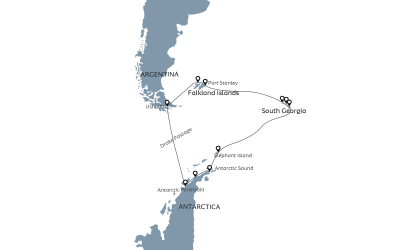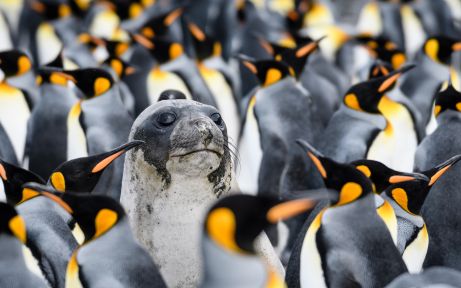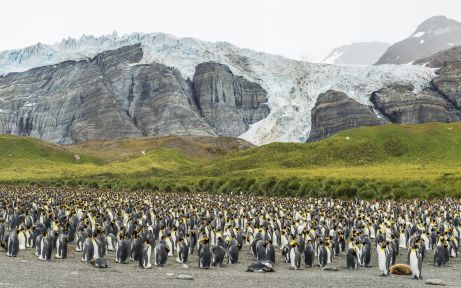We are thrilled to announce the official launch of our new website, Polar Latitudes Expeditions. Discover more in our latest news update, and visit our new website polar-latitudes.com.
Albatros Expeditions veteran expedition leader Jamie Watts shared one of his wonderful Antarctic moments with the Albatros Expedition office team. We felt lucky to read these experiences, that in our minds eye transport us to one of the most secluded areas of Earth. We are happy to share these with you, with Jamie’s permission.
“Perfect moments are never really moments. They don’t happen in isolation, of course, they are the culmination of broader phenomena in space and time. My perfect moments are almost always about wilderness and wildness.
We were at the edge of where most humans have ever reached, off a continent that itself at the edge of where only a few fortunate humans can get to. The Weddell Sea is the extreme Antarctic, at the limit of where we can operate and only briefly visit, the edge of where ships can get to. The whole area is accurately mapped, of course, but only mapped by a handful of expeditions, and the number of people who have touched these places – only for brief periods, when the local summer conditions have allowed it – is tiny. We have satellite eyes on this world these days, but very few real eyes or footprints at ground level. Antarctica defies the sense of ownership that we impose everywhere else on Earth.
The end of January and early February is probably the best time to visit the Weddell Sea – if the weather and the ice cooperates. The weather window that day was perfect, and we awoke to a blue sky and a glassy flat sea. I am beyond spoiled; I have worked on more than twenty voyages into the Weddell Sea, and so I had some idea of what we might expect. Still, it doesn’t get any less awesome (in the true sense of the word) than it was that day, and I’ve never seen better conditions or more big ice. Words seem insufficient; breathtaking, magnificent…
The visibility went on for tens of miles, and all around were dozens of enormous, city-block-sized tabular icebergs. All of them flat-topped and flat sided, maybe 20 metres or so high, with sheer walls of ice plunging more than 100 metres straight down below the surface. To the south of us, the Ronne and Larsen ice shelves flow off the Antarctic continent, two hundred metre-thick slabs of ice floating out onto the Weddell Sea, covering an area larger than France, then breaking up into these ice giants, which then drift north, mixed in with the thin, drifting crust of sea ice that expands out as the sea freezes every autumn. While the sea ice melts around much of Antarctica pretty much to the glacial ice at the coast, persistent sea ice covers much of the western Weddell Sea even in summer. Hundreds of billions of tonnes of floating ice, slowly drifting north. The wreckage of Shackleton’s Endurance is south from here, crushed by the same ever-moving sea ice 105 years ago.
We couldn’t see our morning’s destination for big icebergs until we were right upon it. The Danger Islands. You can’t often get here, even late in the season – the Weddell’s continuously shifting sea ice and giant icebergs, and sometimes fog, keep most of us away for most of the time. We had to approach our anchorage from a new direction, and only when we rounded one of the big bergs could we see that Heroina island was accessible.
The Danger Islands have long been known to support a lot of Adelie penguins, but only a couple of years ago a survey showed there were far, far more of them than had been suspected. Over three quarters of a million breeding pairs. The ice in the area limits how often and how well the marine life here is surveyed, and limits our understanding of this area, but we know it’s biologically very, very rich. Humpback and minke whales, crabeater seals and Adelie penguins gather here, feeding on lots and lots of Antarctic krill and ice krill.
We scouted the landing site early, and it became obvious after I’d done a bit of remodelling to our propeller that the tide was not going to allow a landing that morning. A shame, but it was also clear that the colony was breaking up – we really couldn’t have arrived at a more perfect time to explore the wider area by Zodiac. The chicks had lost all but a few tufts of their down, and were either already off the main island – looking bewildered, as Adelie chicks permanently do, in clusters on nearby ice floes and bergy bits – or in the process of leaving. There was going to be plenty for us to see on the water all around, and it was a gorgeous morning.
So we Zodiac-cruised, and it was magnificent. Across to Beagle Island and to Comb island, around and through the sea ice. We saw tens of thousands of Adelie penguins along the shores, on the ice, porpoising along in the water. Tiny Wilson’s storm petrels flitted around, gorging themselves on krill and amphipods, and the biggest gathering of southern giant petrels I’ve ever seen rafted together on the water between the islands. All in the bright sun, with the backdrop of these wild, rugged, rarely-visited islands and, towering above in every direction. the big tabular ice.
The day stayed bright, and over lunch we headed back toward the Antarctic Sound. We passed the spot where the ship Antarctic had been crushed 118 years ago, almost to the day, leaving Captain Carl Anton Larsen, eighteen other men and the ship’s cat to drag themselves and what they could salvage over the shifting sea ice. The story of that expedition is one of the most remarkable stories of exploration, survival, perseverance and uncanny coincidence and luck, even by Antarctic standards. We headed to where they had headed after their ship was crushed; Paulet Island.
And this was where we found our perfect moment. We anchored off the eastern edge of the old volcano. Most of the giant tabular bergs were now a little distance away. The colony filled the slopes above the beach, up to and beyond the stone hut, built by Larsen’s party and still there. The sea in front of the island was filled with flat floes of sea ice, some the size of a Zodiac, some the size of a tennis court, and plenty of chunky icebergs, from truck-sized to cathedral-sized. And most of these bits of ice had been adopted by the penguins, the adults mixed with the fledglings. As we took the staff boat in to set up the landing site we paused off a low floe covered with a few hundred penguins. I felt my eyes well up just a little. Just a moment here, to watch, soak it up, before we set up the landing site and bring the guests..
Adelie fledglings are pretty easy to tell apart from the adults, even when they’ve lost the last of their brown fluffy down. Their first set of feathers are a blue/grey rather than the black of the adults, their throats have more white, and they are somewhat slighter in build than the adults. While the white eye rings of the adults give them an intense stare, in the youngsters it just looks like shock and panic. They’ve grown so quickly from thumb-sized to thigh-sized, they have no hope of getting used to or even taking complete control of their bodies. They waddle, squeak and flap their still-rubbery flippers. They are comically cute and awkward.
In the water, they aren’t as densely-boned or heavily muscled as their parents, and haven’t even come close to the adults’ magnificent mastery of swimming. Adult penguins are stocky, agile, streamlined, confident slugs of muscle, and their swimming is, kilo for kilo the most powerful on Earth – even compared with animals like tunas or dolphins. The youngsters, trying to get used to their bodies and their capabilities, are like kids who’ve been given the keys to a Porsche, and have absolutely no idea how to handle it. But they need to learn fast. Their parents were easing off on their feeding trips. Time for the youngsters to learn to swim, learn to feed themselves and head offshore before winter sets in. And the leopard seals gather around the colonies at this time of year. So many naïve, succulent, fatty chicks.
On that day, we had in theory been within view of over two million Adelie penguins. A quarter of the species.”
-Jamie Watts







